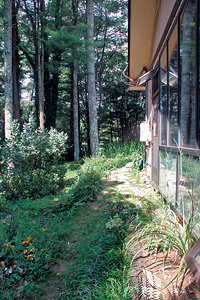Putting the Able in Sustainable: One Homeowner’s Foray into Green Retrofits
Story and photo by Jamie Goodman
After years of dreaming about building or buying a home I finally took the plunge into mortgage ownership this summer.
We decided on a favorable compromise of our lofty fantasies, aspirations and budget; a home originally built in 1979 within easy walking distance of our work, grocery shopping and favorite restaurants and coffee haunts on a quiet, tree-strewn street with just two other houses. The home was in good shape for a member of the 20th century, but it needed a green shot-in-the-arm. First on the list: pull up, take out and recycle the 15-year-old carpet. Then replace it with what?
There were 12 choices in all. Bamboo floors (five distinct types), natural linoleum, marmoleum, recycled milk jug carpeting, reclaimed wood from old buildings, tile made with recycled content, natural stone and cork. Eventually, we went with yet another option, discontinued oak, maple and cherry hardwood flooring from a local wood products vendor. We installed and applied the finish (a non-carcinogenic oil-based sealer with no volatile organic compounds) with the help of some knowledgeable friends.
Mission accomplished.
After that we went searching for low-flow plumbing supplies for the bathroom. We found a kit on Amazon.com that transforms an older toilet into a modern “two-button flush” water-conserving model. And to remediate our crawl space moisture problem? Back to Google, where we found a dizzying number of vendors offering heavy-duty plastic vapor barriers.
It all seems easier now, but at the time our heads swam with the many choices and the endless list of pro-and-cons with each option.
Five years ago I searched for the proverbial needle-in-the-haystack when trying to find green sustainable materials for home repair or furnishings — if such a product even existed. Nowadays, I seem to have the opposite experience. In fact, there are so many choices that it becomes hard to run an apple-to-apples comparison among the twenty or more options.
What a great green problem to have!
We’ve been thinking and planning this issue for a year and a half now. While the Southeast and Appalachia lag behind many regions of the United States in terms of the sustainable economy, the green movement in our region is growing. With this issue, we’ve tried to capture the often unsung efforts of our neighbors, entrepreneurs, non-profits, communities, people of faith and local governments inspiring and leading this momentous undertaking.
We hope it will confirm your many positive suspicions and gut feelings about green living, inspire your wildest sustainable dreams and feed your enduring drive for ecologically sound living within our beautiful Appalachian communities.
So what’s next for our house? Recycled plastic bottle insulation for our attic and floor, replacing our fossil-fuel powered heating system with a wood-waste pellet stove, laying local, recycled Tennessee tile, setting up a greywater/rainwater catchment system, and so on… I imagine it will keep us busy for at least a year or two.
We look forward to meeting you on our shared path of Sustain-a-build-ability.
Related Articles
Latest News

Leave a comment
Your email address will not be published. Required fields are marked *
2 responses to “Putting the Able in Sustainable: One Homeowner’s Foray into Green Retrofits”
-
Hi Reclaimed Wood Desk – we’re actually doing most of the new work ourselves, with help from a few friends (Blue Ridge Innovative Construction Concepts, or BRICC, helped us with a special curve transition in the wood floor). @e are not sure who built the house originally. If I find out I’ll post for you!
-
I’d love to find out who the contractor/architect and or designer was for this property!







Leave a Comment